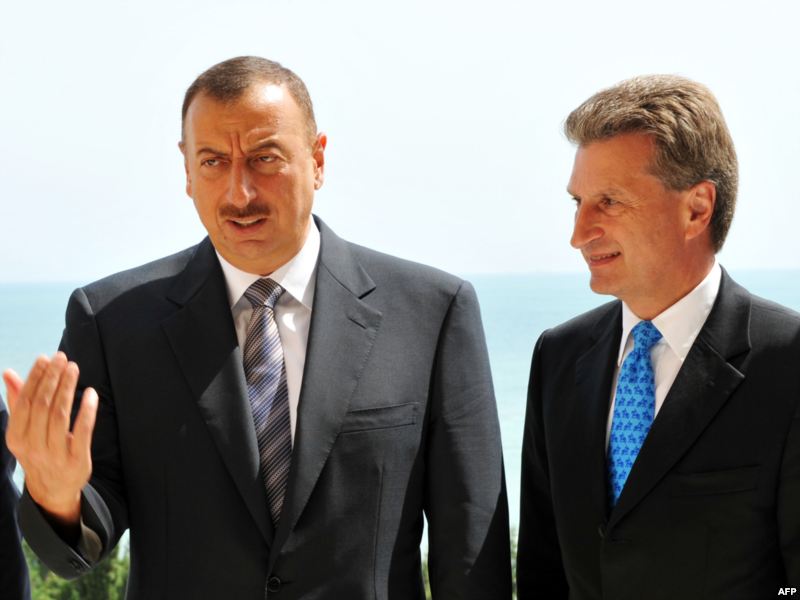
BP’s South-East European Pipeline: More Questions Than Answers On Nabucco and Turkmen Gas
Publication: Eurasia Daily Monitor Volume: 8 Issue: 203
By:

The Izmir agreements on the transit of Azerbaijani gas to Europe through Turkish pipelines (see EDM, November 1) and the BP-proposed South-East European Pipeline for gas (see EDM, November 2) raise some major, as yet unanswered questions. At first sight, they seriously complicate the outlook for the Nabucco project and for the access of Turkmen gas to Europe.
Azerbaijan, BP (operator of the Shah Deniz gas extraction project in Azerbaijan) and Turkey have agreed to use spare capacities in Turkey’s pipelines for delivering Azerbaijani gas to Europe. They further envisage building a new pipeline across Turkey, dedicated to Azerbaijani gas, for transit volumes that will exceed the spare capacities in Turkey’s pipelines. Baku suggests putting the new line’s first stage into operation by 2017 (i.e., when Shah Deniz Phase Two of production comes on stream). No mention is made of the EU-endorsed Nabucco pipeline project. Under existing plans, however, Nabucco would transport the gas from Shah Deniz post-2017. But the agreements and discussions in Izmir imply transferring that role from Nabucco to another pipeline (whether Turkish state-owned or jointly-owned).
Meanwhile, the Nabucco project enjoys an EU-compatible legal framework under the 2009 inter-governmental agreements (IGAs), guaranteeing the consortium’s pipeline ownership and the transit regime. This necessitated years of negotiations and seems difficult to reproduce or transfer to another pipeline, if Nabucco is abandoned. The European Commission has expressed concern on this and related points (Trend, APA, October 27, 28).
In parallel with the Izmir agreements, BP proposes an entirely new concept (and, potentially, system) for transporting Azerbaijani gas from Turkey to Austria. Named the South-East Europe Pipeline (SEEP), it would for the most part use existing nationally-owned pipelines, pipeline sections, and inter-connectors, instead of building the Nabucco pipeline along that entire route. BP’s SEEP is the last-minute entrant in the tender by which the Shah Deniz consortium will choose the transportation solution for Phase Two of gas production. SEEP competes against three pipeline projects, including Nabucco, in this winner-take-all contest. SEEP is a concept, not yet a project at this point. But it can still be fleshed out by early 2012, just in time for the consortium’s decision; and it seems in any case to spare most of the costs of building the Nabucco pipeline. Given BP’s role as the Shah Deniz project operator, SEEP is a strong candidate in this tender.
The Izmir agreements and SEEP initiative, unlike Nabucco, do not envisage a transportation solution for Turkmen gas to Europe. Instead, they foresee throughput capacities matching the guaranteed gas volumes from Shah Deniz, at 10 billion cubic meters (bcm) per year from 2017 onward. In that sense, the transportation solution for Azerbaijani gas seems to be de-coupled from that for Turkmen gas. De-coupling would imply abandoning Nabucco’s unique advantage which combines both solutions in a 31 bcm pipeline.
BP describes the SEEP as a scalable project, implying that it can increase its capacity later. Presumably this would depend on Turkmen gas reaching Azerbaijan across the Caspian Sea. The SEEP, however, does not involve a linear, easily scalable pipeline, but (as BP implies) a patchwork of pipelines, pipeline sections, and inter-connectors, all with varying parameters, characteristics, and ownerships. Scaling up the capacity across such a heterogeneous system needs to be explained more convincingly. Accessing Turkmen gas via Azerbaijan is a high priority of the EU’s external energy policy. Mandated by the EU’s 27 member countries, the European Commission is negotiating with Turkmenistan and Azerbaijan on a trans-Caspian pipeline.
European Energy Commissioner, Guenther Oettinger, has reacted to these latest developments with diplomatically phrased expressions of concern. On gas pipeline options via Turkey, he stated that “Pipeline options within Turkey are led by Nabucco; but alternative options [involving] dedicated infrastructure under a strong legal framework are also being considered.” On the legal framework: as with the 2009 Nabucco IGAs, “this needs to be compatible with EU law.” On access for Turkmen gas: “Whichever option is chosen, there must be mechanisms to allow for new gas from Turkmenistan.” Citing the January 13, 2011 joint declaration by President Ilham Aliyev and European Commission President Manuel Barroso on Caspian gas, the commission intends to discuss with Azerbaijan, Georgia, and Turkey all the pipeline options, with the aim of reaching agreement on the best option (press releases, October 27, 28).
The Izmir agreements and SEEP initiative seem to leave no gas volumes available for the Interconnector Turkey-Greece-Italy (ITGI) and the Trans-Adriatic Pipeline (TAP, connecting Turkey via Greece and Albania to Italy). Those two projects, at 10 bcm of gas annually for each, competed against Nabucco in the zero-sum contest over Shah Deniz gas. SEEP is the fourth, last entrant in the tender. The most influential players involved are interested mainly in supplying Balkan and Central European countries with gas. The geographies of Nabucco and SEEP closely overlap in that direction. Each plans for its gas flow to turn north from Turkey into Bulgaria, and onward to Central Europe. Apart from 1 bcm or 2 bcm annually that Azerbaijan plans to deliver via Turkey to Greece, no other volumes are known to be planned for delivery westward of Bulgaria at this stage.




